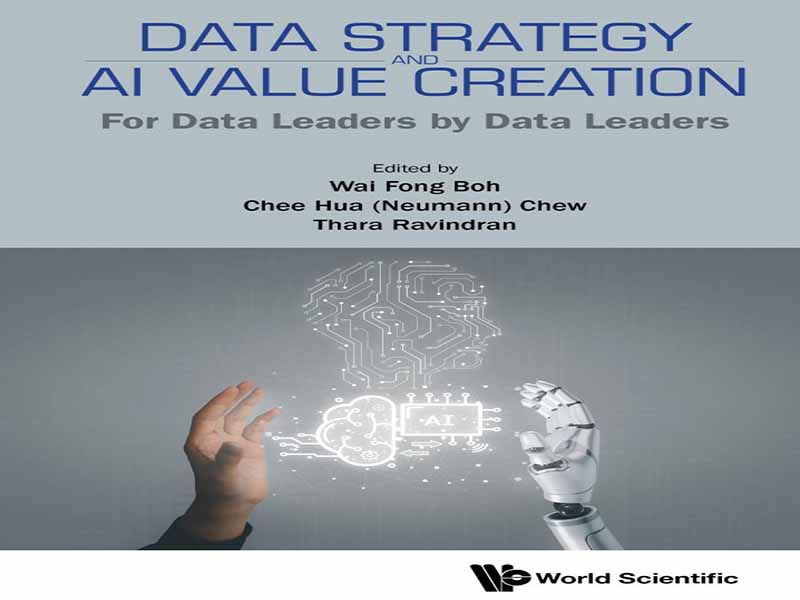- عنوان کتاب: Data Strategy and AI Value Creation For Data Leaders by Data Leaders
- نویسنده: Wai Fong Boh
- حوزه: یادگیری عمیق
- سال انتشار: 2025
- تعداد صفحه: 250
- زبان اصلی: انگلیسی
- نوع فایل: pdf
- حجم فایل: 7.04 مگابایت
ما دهههاست که با دادهها و هوش مصنوعی (AI) زندگی میکنیم. هوش مصنوعی به دادهها به عنوان سوخت نیاز دارد. ما دادهها را میشناسیم و از آنها استفاده میکنیم. ما در مورد پیشبینیهای هوش مصنوعی (مثلاً وامهای بانکی، مطالبات بیمه، تراکنشهای کارت اعتباری و خدمات بیمارستانی) اطلاعات داریم و در معرض آنها قرار گرفتهایم. با این حال، دو رویداد اخیر نحوه نگاه اکثر مردم به دادهها و هوش مصنوعی را تغییر داده است – کووید-۱۹ و هوش مصنوعی مولد. کووید-۱۹ اهمیت، قدرت و محدودیتهای دادهها را برجسته کرد. دادهها به عنوان عنصر حیاتی برای درک وضعیت واقعی مهم هستند. ویروس کرونا چقدر مسری است؟ کووید-۱۹ چقدر کشنده است؟ تفاوت بین کووید-۱۹ و آنفولانزای فصلی چیست؟ نظر کارشناسان یک چیز است، اما دادهها پایه و اساس را فراهم میکنند. کارشناسان برای شکل دادن به نظر خود و توجیه توصیههای خود به دادهها نیاز دارند. عموم مردم برای درک وضعیت واقعی و پذیرش/رد فرضیات، اطلاعات و اقدامات لازم به دادهها نیاز دارند. نیاز به دادههای به موقع و دقیق اکنون بیش از گذشته احساس میشود. کمبود دادهها، ناتوانی و شایعات را تداوم میبخشد. دادههای دست کم گرفته شده باعث ایجاد رضایت از خود میشوند؛ دادههای بیش از حد تخمین زده شده باعث گسترش ترس اغراقآمیز میشوند. تصمیمات دولتها، بیمارستانها، کسبوکارها و شهروندان به دادههای بهموقع، دقیق و مرتبط نیاز دارد. کیفیت دادهها میتواند به معنای تفاوت بین مرگ و زندگی، رونق و ورشکستگی باشد. با این حال، کمبود دادهها میتواند به اندازه دادههای نادرست مخرب باشد. بنابراین، قدرت دادهها در مواقع استرس و عدم قطعیت زیاد احساس میشود. در پاسخ، علاوه بر دولتها و نهادهای بینالمللی، برخی دانشگاهها، مراکز پزشکی و مخازن داده شروع به جمعآوری و انتشار دادهها در مورد کووید-۱۹ کردند. اما دادههای جمعآوریشده توسط یک طرف ممکن است برای استفاده طرف دیگر مرتبط یا کافی نباشد. اغلب، هدف و مقاصد طرفهای مختلف ممکن است یکسان نباشد. طرفهایی که دادهها را ارائه میدهند و از آنها استفاده میکنند، حتی ممکن است یکدیگر را نشناسند. دیر یا زود، ممکن است متوجه شویم که تعاریف دادهها یکسان نیستند، حتی اگر طرفهای مختلف از نام متغیر یکسانی استفاده کنند. این میتواند برای دادهها در سیستمهای مختلف و حتی دادههایی که از یک پایگاه داده میآیند، اتفاق بیفتد. علاوه بر این، برخی از واحدهای اندازهگیری متناقض هستند. اگر یک ارائهدهنده داده نتواند تمام دادههای مورد نیاز را ارائه دهد، شاید بتوانیم دادههای خود را با دادههای شخص ثالث ترکیب کنیم؟ اما گفتن این کار آسانتر از انجام دادن آن است. مجموعه دادههای مختلف روی موجودیتهای یکسان به دلیل فقدان معیارهای تطبیق مشترک، قابل ادغام نیستند. ما نمیتوانیم تصویر کامل را با قطعات جداگانه مجموعه دادهها ببینیم. بنابراین، میدانیم که اطلاعات مهم وجود دارد اما قفل شده و تکهتکه است. باید راهی برای دیدن تصویر کامل وجود داشته باشد، اما نمیدانیم چگونه، حتی اگر بتوانیم مجموعه دادههای مرتبط را از منابع متعدد دانلود کنیم. در حالی که ما توسط دادهها توانمند میشویم، توسط دادهها و نحوه ثبت آنها نیز محدود میشویم. دسترسی به دادهها یک چیز است، اما استخراج بینش از دادهها چیز دیگری است. مشکل در جزئیات و پیادهسازی سیستمهای داده است. اما به نظر میرسد مشکلاتی که امروزه با دادهها مواجه هستیم، همان مشکلاتی است که رهبران داده ۱۰۰ سال پیش با آن مواجه بودند، البته با حجم و سرعت بیشتر در حال حاضر. از این رو، این کتاب قصد دارد مشکلات زمان ما را به صورت دیگری بیان کند و ایدهها و راهحلهایی را ارائه دهد که میتواند به مدیریت بهتر دادهها در حال حاضر کمک کند. در مقابل، توانایی ما برای استخراج بینش از دادهها، به ویژه با ورود به دوران یادگیری ماشین و هوش مصنوعی، به طرز چشمگیری افزایش یافته است. در جوامع مدرن، ما در زندگی روزمره خود تحت تأثیر نتایج یادگیری ماشینی و مدلهای هوش مصنوعی قرار داریم، حتی اگر متوجه آن نباشیم. یک مدل تعیین میکند که آیا کسی وام بانکی دریافت میکند یا خیر. یک مدل حق بیمهای را که فرد باید پس از موافقت مدل دیگری مبنی بر ریسک قابل قبول پرداخت کند، تعیین میکند. یک مدل مدت زمانی را که یک بیمار میتواند برای مراجعه به پزشک در اورژانس منتظر بماند، تعیین میکند. اخیراً، یک قاضی آمریکایی بر اساس نتایج یک مدل در مورد حکمی تصمیم گرفت. ما با استفاده از مدلهای یادگیری ماشینی و هوش مصنوعی که در چند دهه اخیر اختراع شدهاند، در استخراج بینش از دادهها بهتر میشویم. هوش مصنوعی و یادگیری ماشینی با جهشها و مرزها پیشرفت کردهاند و اکنون یک ستاره جدید در فضای هوش مصنوعی وجود دارد – هوش مصنوعی مولد. هوش مصنوعی مولد، و به ویژه ChatGPT، بسیار محبوب است زیرا مفید بودن هوش مصنوعی را اثبات میکند و هر کسی میتواند از آن استفاده کند. متن، صداها و تصاویر تولید شده خودکار از بسیاری جهات برای بسیاری از مردم مفید هستند، اما هیجان این است که هر کسی میتواند به صورت رایگان از آن استفاده کند و در نتیجه پتانسیل بیپایانی را ارائه میدهد. ما دیگر فقط تحت تأثیر هوش مصنوعی نیستیم، بلکه میتوانیم خودمان از هوش مصنوعی برای انجام سریعتر، بهتر و ارزانتر کار استفاده کنیم. رهبران داده که پیشرفت یادگیری ماشین و هوش مصنوعی را دنبال نکردهاند، برای درک سودمندی، پتانسیل، محدودیتها و خطرات هوش مصنوعی غیرمولد و هوش مصنوعی مولد، باید مطالب زیادی را فرا بگیرند. از این رو، این کتاب تلاشی است برای توضیح ساده و در یک زمینه تجاری، کاربرد و پتانسیل هوش مصنوعی غیرمولد و مولد که پس از آن میتوان محدودیتها و خطرات را استنباط کرد.
We have been living with data and artificial intelligence (AI) for decades. AI needs data as fuel. We know and use data. We know about and have been subjected to AI predictions (e.g., bank loans, insurance claims, credit card transactions, and hospital services). However, two recent events changed the way most people viewed data and artificial intelligence — COVID-19 and generative AI. COVID-19 highlighted the importance, power, and limitations of data. Data are important as the critical ingredient for understanding the actual situation. How contagious is the coronavirus? How deadly is COVID-19? What is the difference between COVID-19 and the seasonal flu? Expert opinion is one thing, but data provide the foundation. Experts need data to form their opinion and justify their recommendations. The public needs data to understand the actual situation and accept/reject assumptions, information, and actions to take. The need for timely and accurate data is felt more acutely now than before. The lack of data perpetuates powerlessness and hearsay. Underestimated data build complacency; overestimated data spread exaggerated fear. Decisions by governments, hospitals, businesses, and citizens need timely, accurate, relevant data. The quality of data could mean the difference between life and death, prosperity and bankruptcy. However, the lack of data could be as destructive as wrong data. Thus, the power of data is felt in times of great stress and uncertainty. In response, in addition to governments and international bodies, some universities, medical centers, and data repositories started collecting and publishing data on COVID-19. But data collected by one party might not be relevant to or sufficient for use by another. Often, the purpose and objectives of different parties may not be the same. The parties providing and using the data may not even know each other. Sooner or later, one may realize that data definitions are not the same, even if different parties use the same variable name. This can happen for data in different systems and even data that come from the same database. Furthermore, some units of measurement are inconsistent. If a data provider cannot provide all the data that one requires, perhaps we could combine our data with data from a third party? But this is easier said than done. Different datasets on the same entities cannot be merged due to a lack of common matching criteria. We cannot see the full picture with isolated pieces of datasets. Thus, we know that important information exists but it is locked and fragmented. There must be a way to see the full picture, but we do not know how, even if we can download related datasets from multiple sources. While we are empowered by data, we are also limited by data and the way they are recorded. Gaining access to data is one thing, but extracting insights from data is another. The devil is in the details and in the implementation of data systems. But the problems with data that we face today seem to be the same as those faced by data leaders 100 years ago, albeit at a greater volume and velocity now. Hence, this book aims to rephrase the problems of our time and provide ideas and solutions that could help forge better management of data at present. In contrast, our ability to extract insights from data has grown by leaps and bounds, especially with the arrival of the machine learning and AI era. In modern societies, we are subjected to the results of machine learning and AI models in our everyday life, even if we do not realize it. A model determines whether someone gets a bank loan or not. A model determines the insurance premiums someone has to pay after another model agrees that he/she is of acceptable risk. A model determines how long a patient can wait to see a doctor at the emergency room. Recently, a US judge decided on a sentence based on the results of a model. We are getting better at extracting insights from data by using machine learning and AI models invented in the last few decades. AI and machine learning have progressed by leaps and bounds, and now there is a new star in the AI space — generative AI. Generative AI, and ChatGPT in particular, is very popular because it is proving the usefulness of AI and anyone can use it. Auto-generated text, sounds, and pictures are useful in many ways to many people, but the excitement is because anyone can use it for free, thereby offering endless potential. We are no longer just subjected to AI, but we could use AI ourselves to do work faster, better, and cheaper. Data leaders who have not been following the progress of machine learning and AI will have a lot to catch up on in order to understand the usefulness, potential, limitations, and dangers of non-generative AI and generative AI. Hence, this book is an attempt to explain in simple terms and in a business context the use and potential of non-generative and generative AI after which the limitations and dangers can be inferred.
این کتاب را میتوانید از لینک زیر بصورت رایگان دانلود کنید:
Download: Data Strategy and AI Value Creation For Data Leaders




































نظرات کاربران